Mat clark – Ielts speaking
Chinese Performance
As an IELTS examiner, I tested speaking candidates in most Chinese cities. I have
often heard stories about candidates in certain cities getting higher scores than others, for
example, ―Candidates in Beijing get higher scores than candidates in Wuhan.‖ This is
actually an ―IELTS myth‖ and there is no truth in this theory. In reality, there is a nationwide
trend of score averages and although some tests may contradict this trend on certain dates,
the scoring average is quite consistent.
On average, 15~20% of candidates score below 5 (mostly 4); 60% of candidates
score 5; 15~20% of candidates score 6; less than 5% score 7; a very small number of
candidates score 8 or 9. (In my 5 year career of IELTS testing in China, which covered
around 4,000 interviews I did not award a single speaking 9!)
From these numbers we can make the assumption that in general, Chinese candidates
find it quite easy to score 5, but there are clearly some problems with scoring 6, 7 and 8.
I always begin a new IELTS speaking class by asking my students what score they
need for speaking and the response is usually:
40% need a speaking score of 6;
60% need a speaking score of 7;
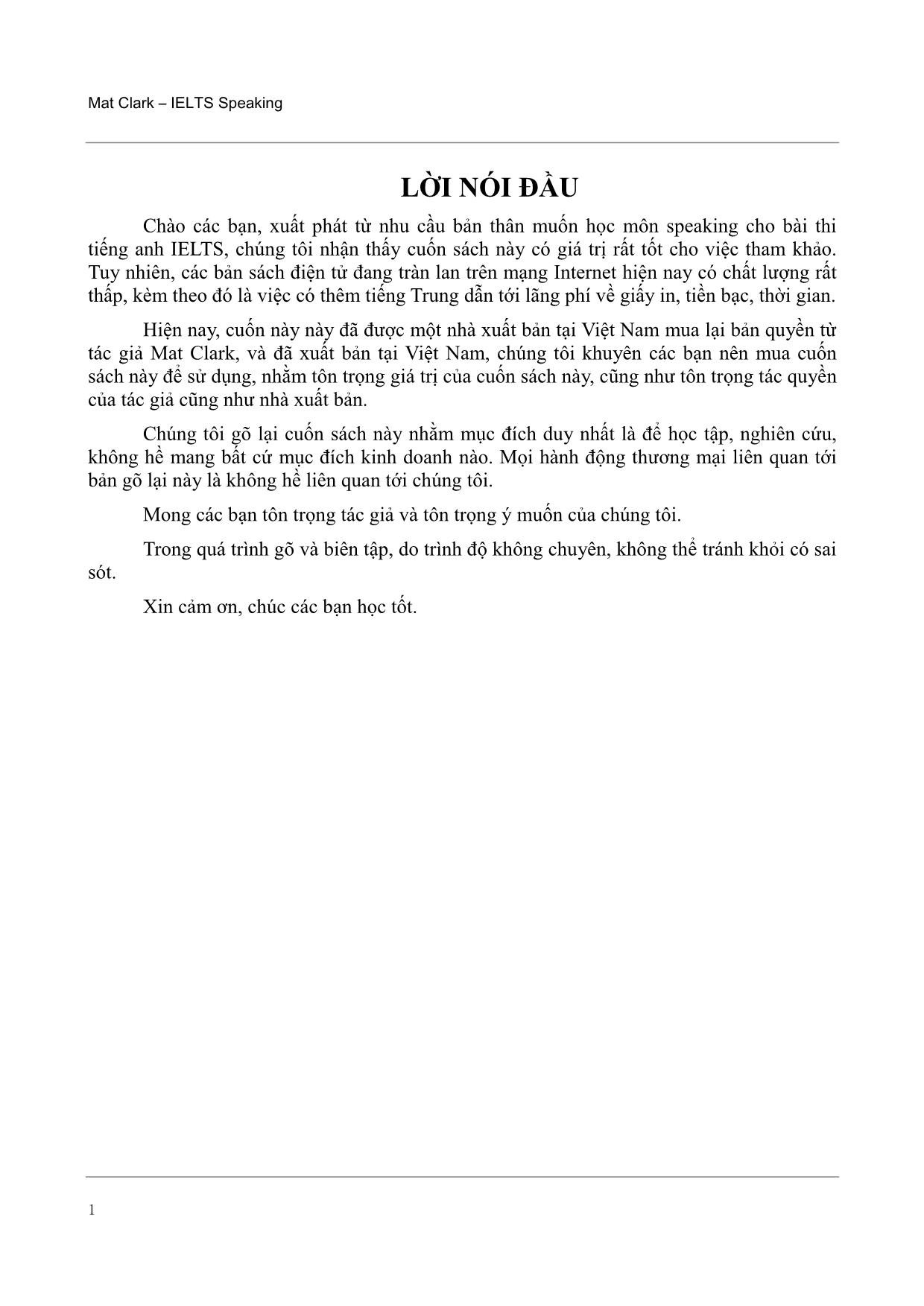
Trang 1
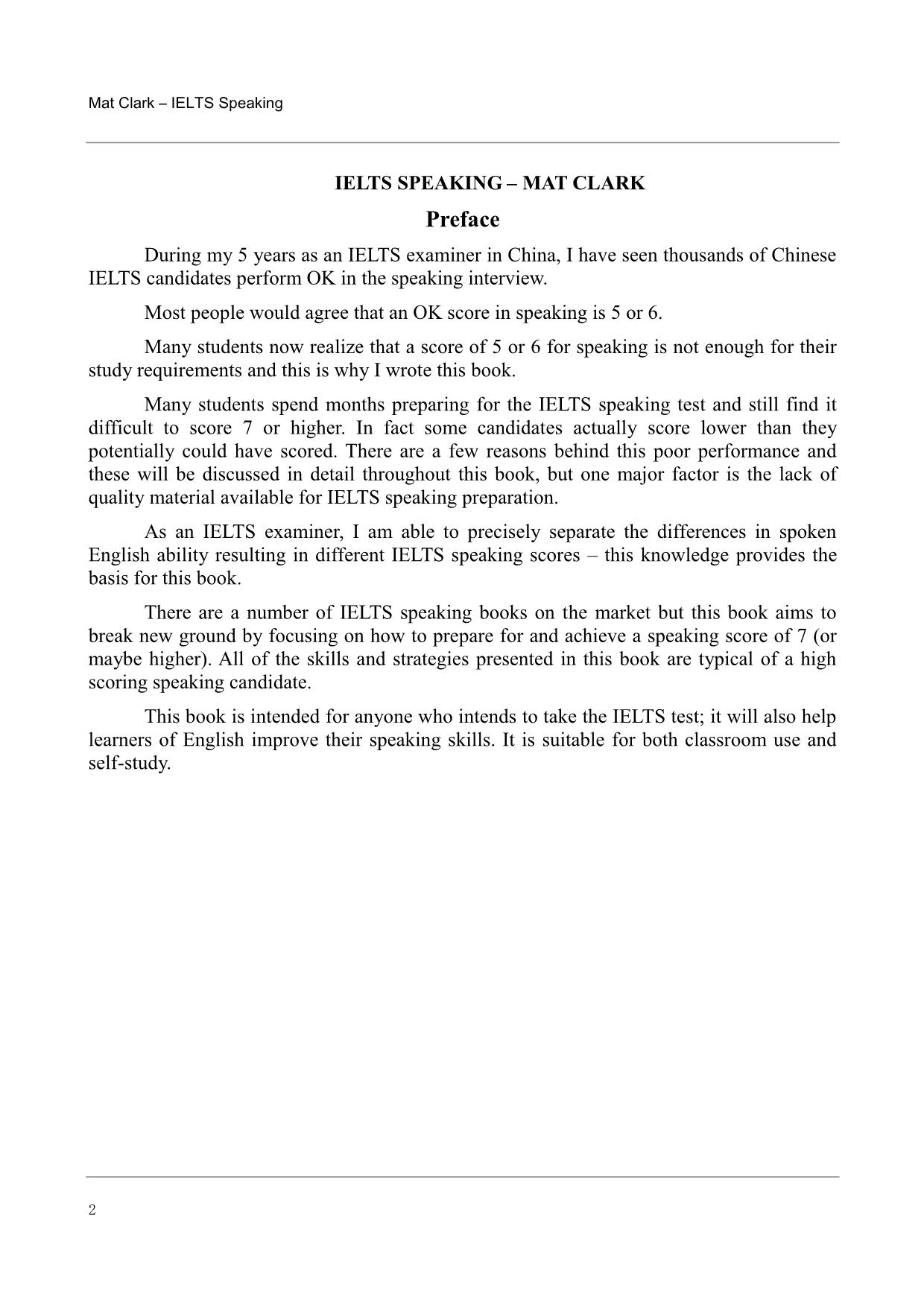
Trang 2
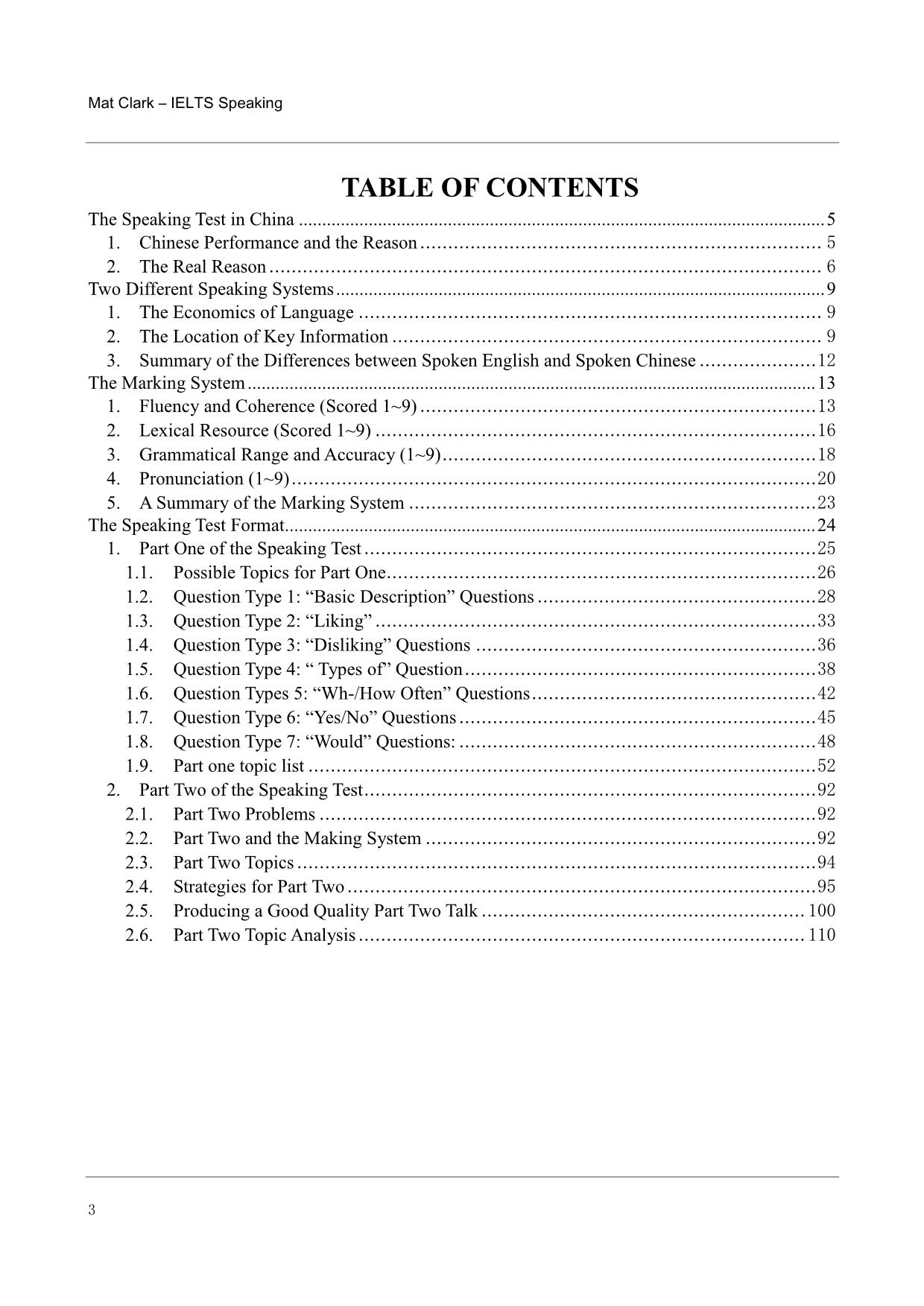
Trang 3
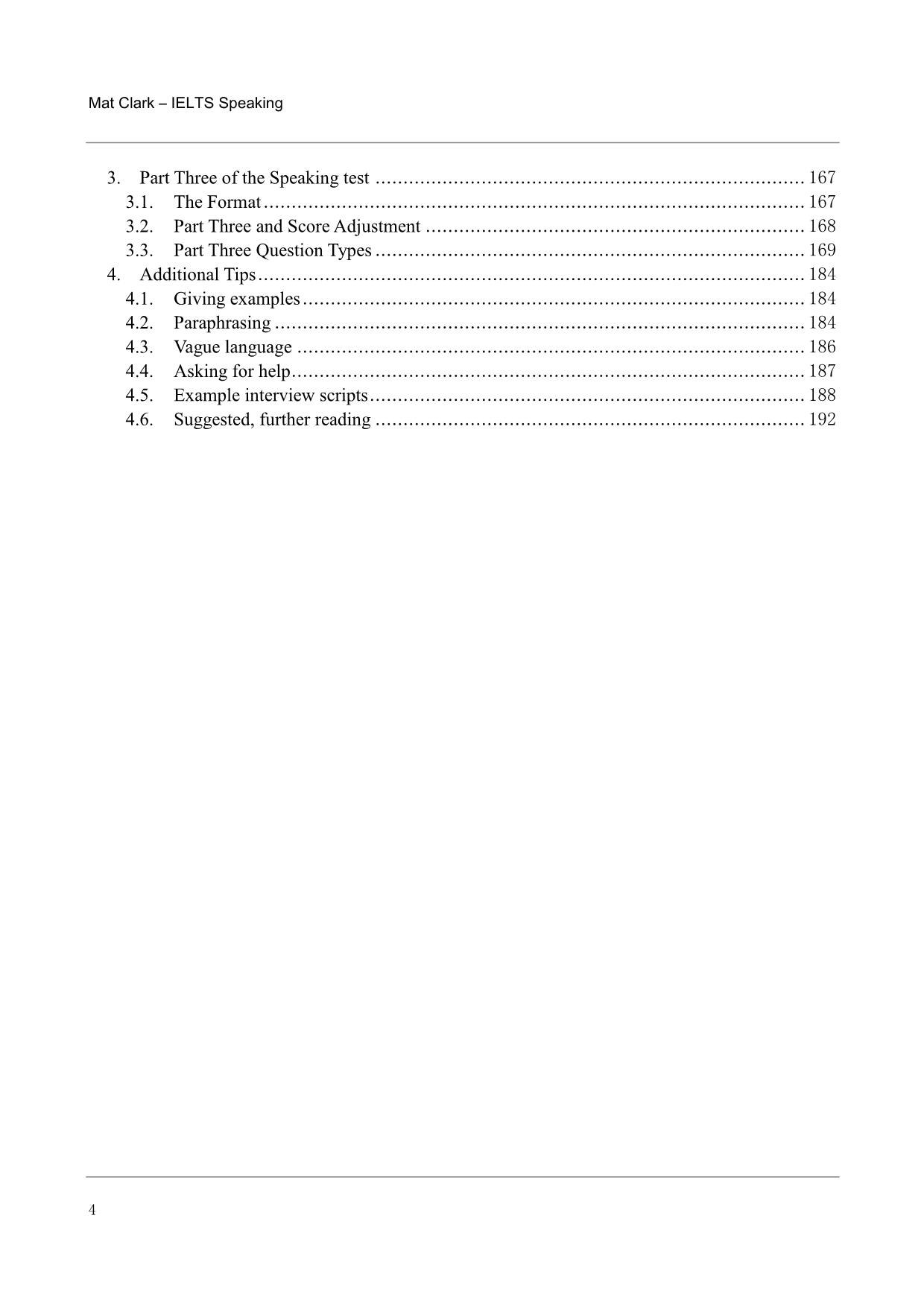
Trang 4
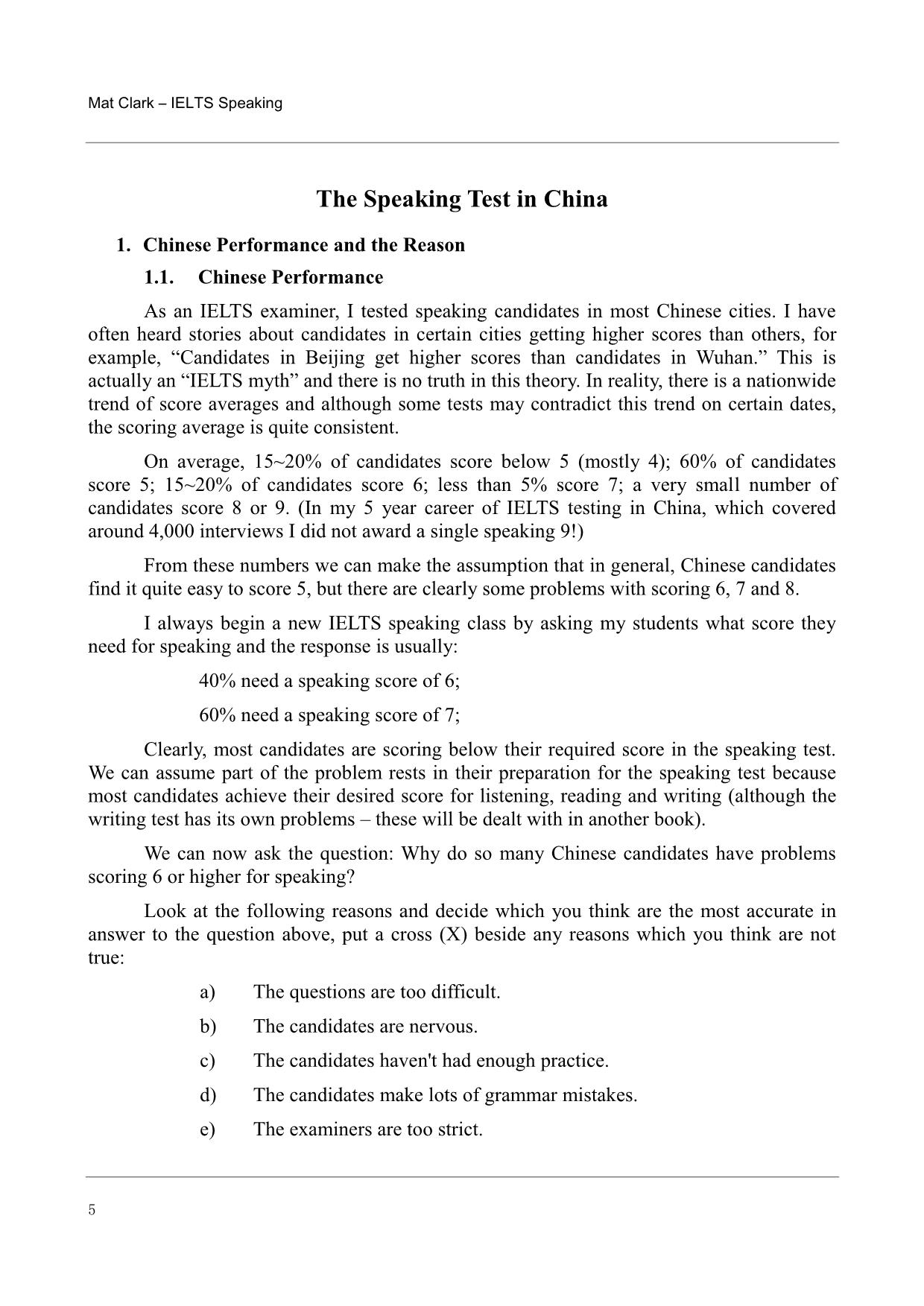
Trang 5
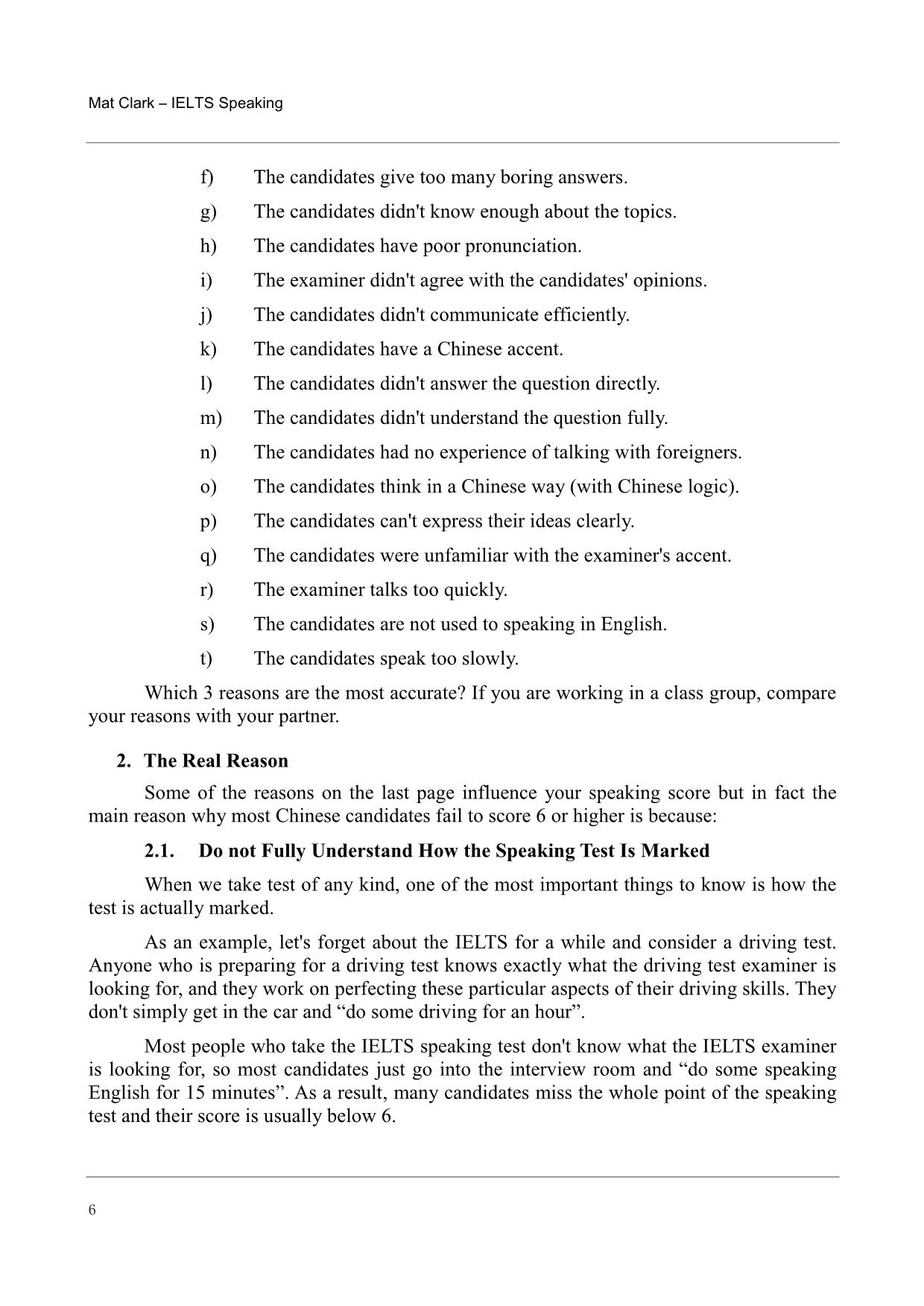
Trang 6
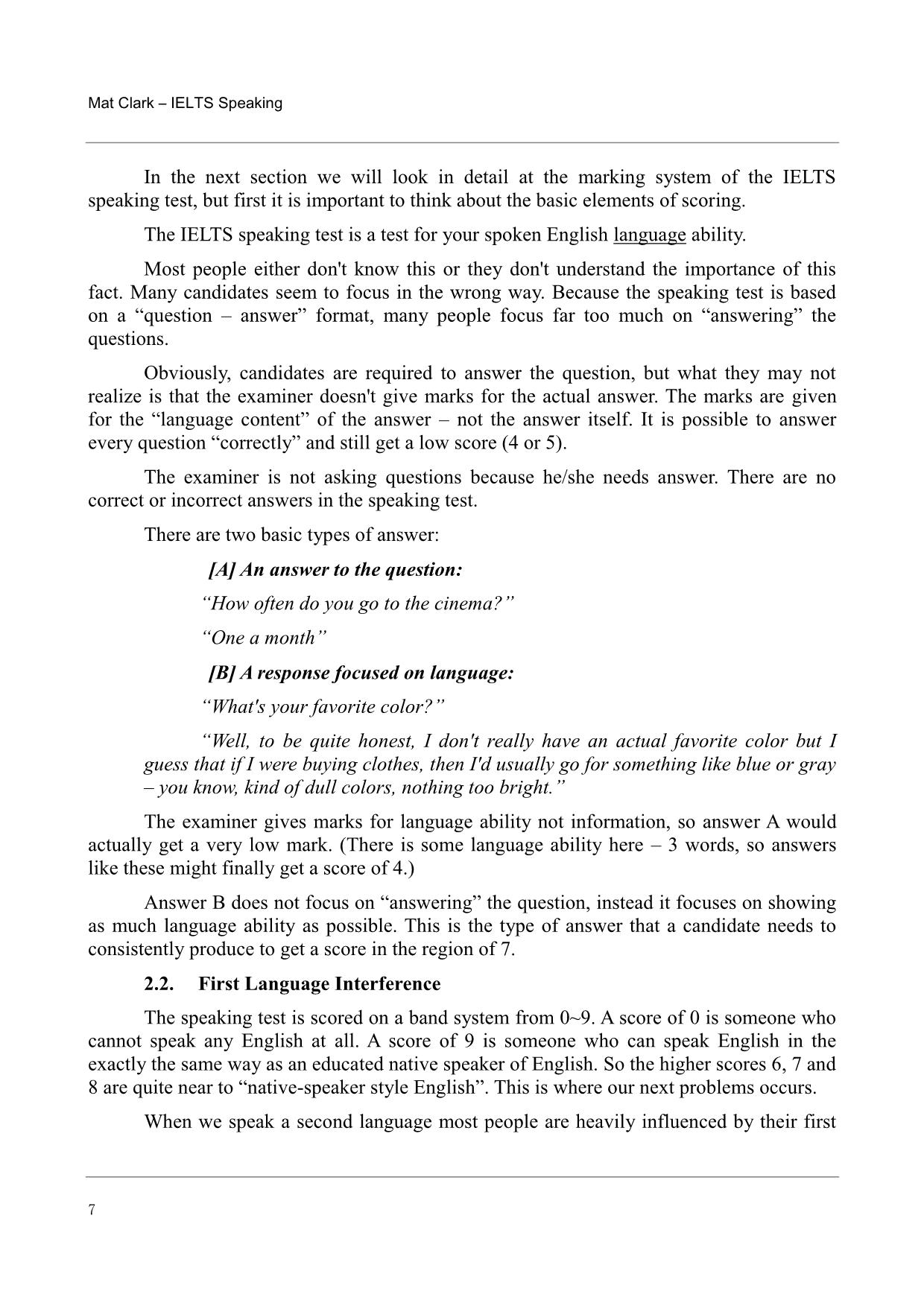
Trang 7
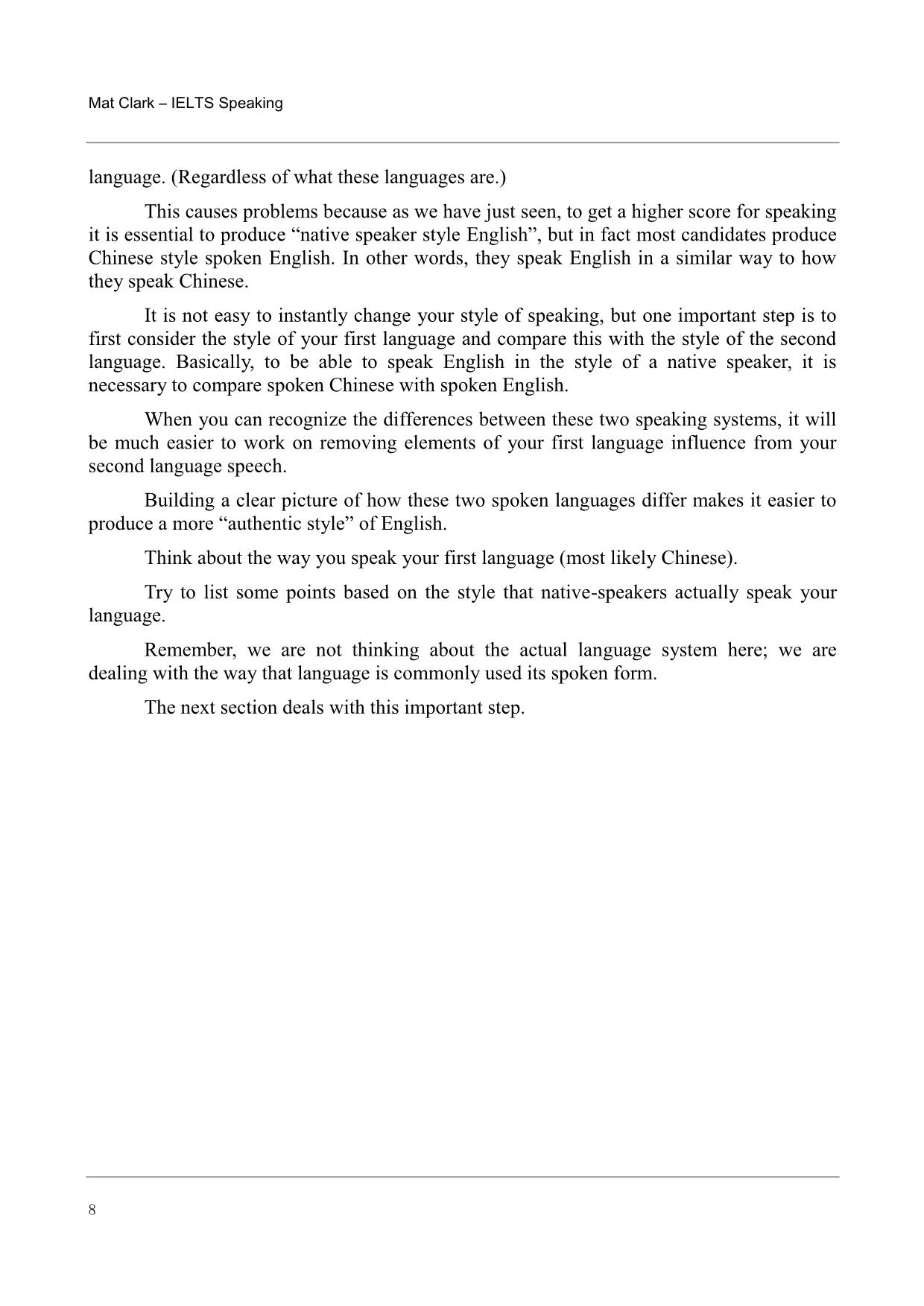
Trang 8
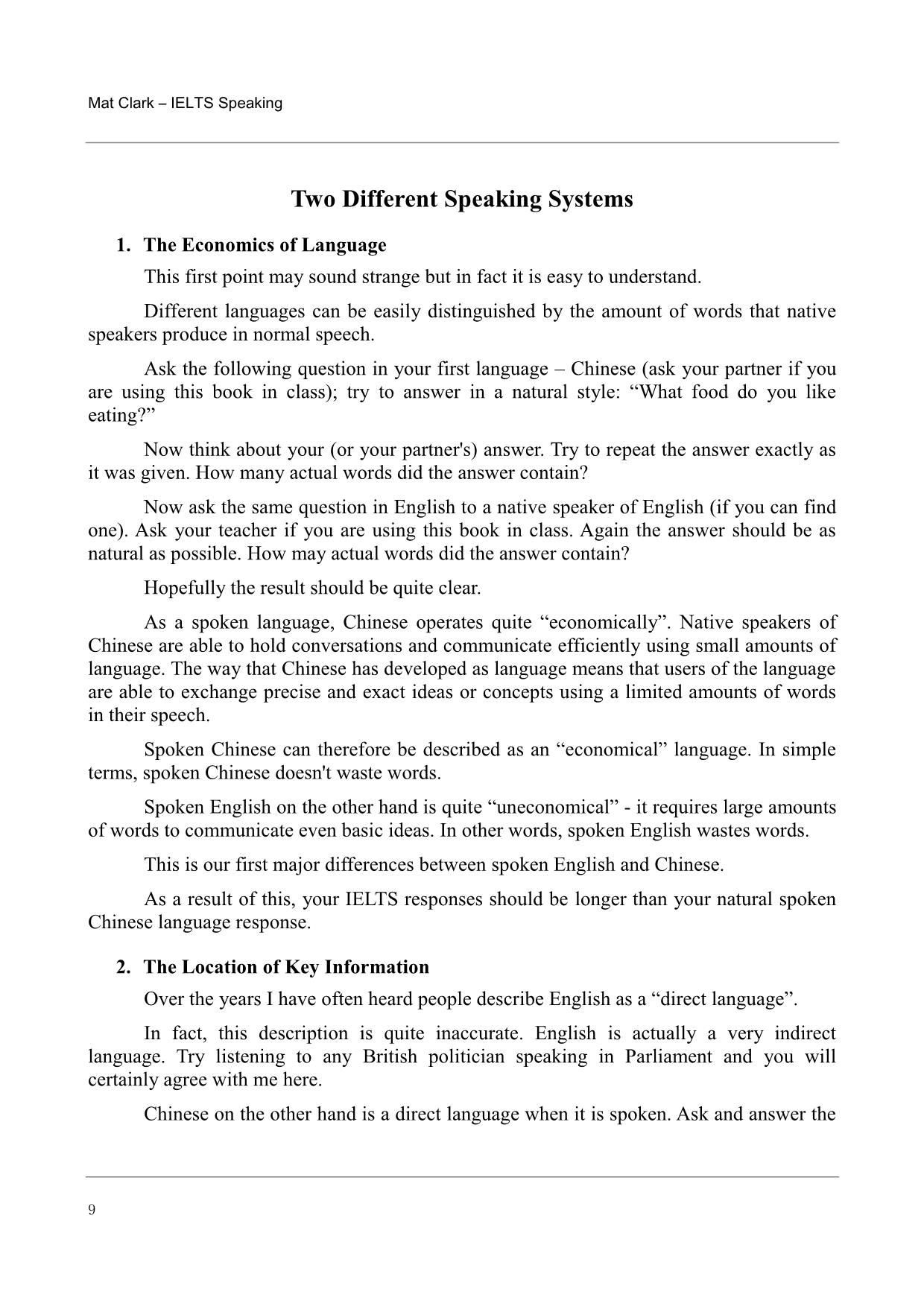
Trang 9
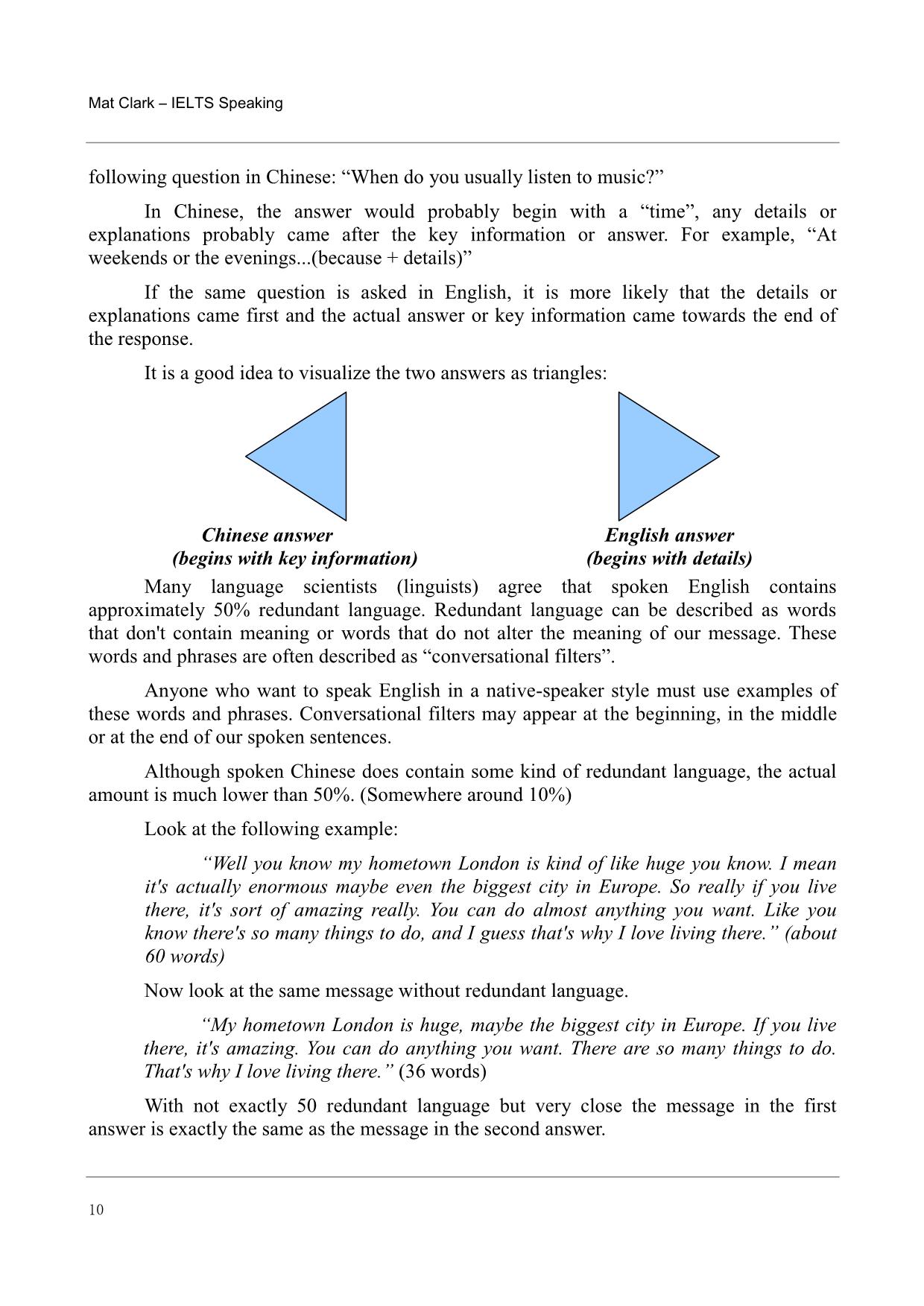
Trang 10
Tải về để xem bản đầy đủ
Tóm tắt nội dung tài liệu: Mat clark – Ielts speaking
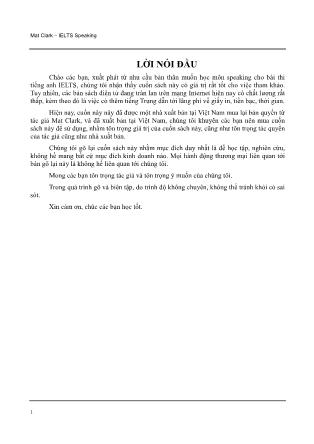
Mat Clark – IELTS Speaking 1 LỜI NÓI ĐẦU Chào các bạn, xuất phát từ nhu cầu bản thân muốn học môn speaking cho bài thi tiếng anh IELTS, chúng tôi nhận thấy cuốn sách này có giá trị rất tốt cho việc tham khảo. Tuy nhiên, các bản sách điện tử đang tràn lan trên mạng Internet hiện nay có chất lượng rất thấp, kèm theo đó là việc có thêm tiếng Trung dẫn tới lãng phí về giấy in, tiền bạc, thời gian. Hiện nay, cuốn này này đã được một nhà xuất bản tại Việt Nam mua lại bản quyền từ tác giả Mat Clark, và đã xuất bản tại Việt Nam, chúng tôi khuyên các bạn nên mua cuốn sách này để sử dụng, nhằm tôn trọng giá trị của cuốn sách này, cũng như tôn trọng tác quyền của tác giả cũng như nhà xuất bản. Chúng tôi gõ lại cuốn sách này nhằm mục đích duy nhất là để học tập, nghiên cứu, không hề mang bất cứ mục đích kinh doanh nào. Mọi hành động thương mại liên quan tới bản gõ lại này là không hề liên quan tới chúng tôi. Mong các bạn tôn trọng tác giả và tôn trọng ý muốn của chúng tôi. Trong quá trình gõ và biên tập, do trình độ không chuyên, không thể tránh khỏi có sai sót. Xin cảm ơn, chúc các bạn học tốt. Mat Clark – IELTS Speaking 2 IELTS SPEAKING – MAT CLARK Preface During my 5 years as an IELTS examiner in China, I have seen thousands of Chinese IELTS candidates perform OK in the speaking interview. Most people would agree that an OK score in speaking is 5 or 6. Many students now realize that a score of 5 or 6 for speaking is not enough for their study requirements and this is why I wrote this book. Many students spend months preparing for the IELTS speaking test and still find it difficult to score 7 or higher. In fact some candidates actually score lower than they potentially could have scored. There are a few reasons behind this poor performance and these will be discussed in detail throughout this book, but one major factor is the lack of quality material available for IELTS speaking preparation. As an IELTS examiner, I am able to precisely separate the differences in spoken English ability resulting in different IELTS speaking scores – this knowledge provides the basis for this book. There are a number of IELTS speaking books on the market but this book aims to break new ground by focusing on how to prepare for and achieve a speaking score of 7 (or maybe higher). All of the skills and strategies presented in this book are typical of a high scoring speaking candidate. This book is intended for anyone who intends to take the IELTS test; it will also help learners of English improve their speaking skills. It is suitable for both classroom use and self-study. Mat Clark – IELTS Speaking 3 TABLE OF CONTENTS The Speaking Test in China ................................................................................................................. 5 1. Chinese Performance and the Reason ........................................................................ 5 2. The Real Reason ................................................................................................... 6 Two Different Speaking Systems ......................................................................................................... 9 1. The Economics of Language ................................................................................... 9 2. The Location of Key Information ............................................................................. 9 3. Summary of the Differences between Spoken English and Spoken Chinese ..................... 12 The Marking System .......................................................................................................................... 13 1. Fluency and Coherence (Scored 1~9) ....................................................................... 13 2. Lexical Resource (Scored 1~9) ............................................................................... 16 3. Grammatical Range and Accuracy (1~9) ................................................................... 18 4. Pronunciation (1~9) .............................................................................................. 20 5. A Summary of the Marking System ......................................................................... 23 The Speaking Test Format.................................................................................................................. 24 1. Part One of the Speaking Test ................................................................................. 25 1.1. Possible Topics for Part One............................................................................. 26 1.2. Question Type 1: ―Basic Description‖ Questions .................................................. 28 1.3. Question Type 2: ―Liking‖ ............................................................................... 33 1.4. Question Type 3: ―Disliking‖ Questions ........................................ ... examiner refers to whilst listing to your spoken English. The sections are divided into scores in the following way: <I skipped this part because the band score table of speaking test could be easily downloaded.> Each box in the table contains a very detailed description of the features required for that score in that section. The box for ―Fluency and Coherence 7‖ contains a 50-word detailed description of all of the things a candidate must do to get a score of seven in this section. Directly above and below the examiner can see the description for 8 and 6, in this way the examiner can listen to your language in the interview and decide carefully which description best fits your language. It is important to understand this because many people do not realize that, for example, a score of 7 for ―Lexical Resource‖ can only be awarded if your vocabulary exactly fits the description in that box. The descriptions are written in professional linguistic terms so it would not be very useful to reproduce them here. Instead, the following section will translate into simple terms the language features a candidate must produce to achieve scores of 6, 7 and 8. 1. Fluency and Coherence (Scored 1~9) In general terms, the score for ―Fluency and Coherence‖ refers to the ways that the candidate speaks. The features described in the marking system for this section include: Ability to produce long responses How easily the candidate can produce the long responses The amount of hesitation Mat Clark – IELTS Speaking 14 The speed of speech Use of discourse markers/ linking phrases/ connectives The amount of self-correction Fluency and Coherence 6 According to the marking system, the examiner will award a 6 in this section if the candidate produces the following features: Be able and willing to produce long responses to most questions. Produce a range of different linking words/ phrases. Linking phrases are sometimes used incorrectly. Use some ―marker‖ language (eg, redundant language). There is some hesitation/ repetition/ self-correction. So from the above, it is clear that a Fluency 6 is the score where candidates begin to produce native-speaker style language features in longer answers. A Fluency 5 lacks most of these features. Fluency and Coherence 7 The examiner will award 7 in this section if the candidate can produce the following: Can produce long responses easily. Produces a wide range of linking words, phrases and connectives. Uses different linkers in a flexible ways. Responses are relevant to the topic. There is some hesitation/ repetition/ self-correction (but these do not affect understanding and meaning). From the above it can be concluded that a Fluency 7 is awarded when the responses are usually long and they contain a larger quantity of linking devices (redundant language etc.) Fluency and Coherence 8 The examiner will give 8 in this section if the candidate can produce the following features of language: Fluent use of a wide range of linking language features. Occasional hesitation/ repetition. Mat Clark – IELTS Speaking 15 Long responses are easily delivered and are directly relevant to the topic. Use cohesive features (linking phrases) accurately. A Fluency and Coherence 8 score is very close to native speaker level. Summary of Fluency and Coherence Many people believe that the ―Fluency‖ score is based on the speed and flow of speech. From the marking system descriptions it can be seen that these aspects are only a small part of the actual score. The most important aspect of your ―Fluency and Coherence‖ score is the length of your response and your use of cohesive features such as linking words, discourse markers, connectives and redundant phrases. Problems with Fluency and Coherence The most common problem that Chinese candidates face in this section of the marking system is that they focus to heavily on answering the question. In other words, their answers contain ― information content‖ but lack the language to link these ideas together. Look at the following example: “What do you like about your hometown?” “My hometown is Wuhan. Wuhan is very modern so I like the buildings. All over the city there are lots of new interesting buildings being built. When I was younger most of the buildings looked the same so it wasn't as attractive as it is nowadays.” The answer above is not a bad answer. In fact the grammar is fairly complex and accurate; it is not too short. The problem with this answer is that it lacks cohesive features. Now compare the following answer: “Well you know, my hometown is Wuhan and you might not know this but Wuhan is a very modern, so I suppose I would have to say I like the buildings. Actually, all over the city there are lots of new interesting buildings being built. In fact, it's quite interesting to consider that when I was younger most of the building looked the same, so you know it wasn't as attractive as it is nowadays.” The content in the answer above is exactly the same as the first answer. The difference in this second answer is that the information is linked using native-speaker style cohesive features. The answer above would most likely be typical of a Fluency and Coherence 7 or 8. (There is a section later which deals with cohesive language in detail.) A second problem with coherence is when candidates avoid the question by talking Mat Clark – IELTS Speaking 16 about something else. Look at the following example: “What sports do you like?” “I don't like sports. I like computer games. My favorite computer game is Counter Strike and this game is very popular in China now. I like Counter Strike because...” This situation happens quite often in the speaking test. If it happens once or twice, the examiner probably won't change your score. If it happens frequently then your ―Fluency and Coherence‖ will be reduced. 2. Lexical Resource (Scored 1~9) Many people (even examiners) call this section as the ―vocabulary‖ score. There are some common misunderstandings about how this score is awarded. I have often been asked the following question: ―How many words do I need to know to get a vocabulary score of 7?‖ This question is almost impossible to answer because the marking system does not base the ―Vocabulary‖ score on how many words you know. The ―Vocabulary‖ section of the marking system is based on the type of words you use and how you use them. The language points featured in this section of the marking system include: Ability to use lest common words Use of idiomatic language Paraphrasing (explaining words that you don't know) Ability to talk about unfamiliar topics Ability to convey precise meaning A candidate will score 6 in this section if he/ she can produce the following features: Can produce vocabulary for most topics in some detail. Can explain ―vocabulary gaps‖ by using other words. Does not confuse meaning by using vocabulary incorrectly. A Lexical Resource 6 is not difficult to score. In general, Chinese candidates can score 6 in this section quite easily because they usually know quite a lot of English words and have prepared vocabulary for most topics. If a candidate fails to paraphrase or explain Mat Clark – IELTS Speaking 17 ―vocabulary gaps‖ this may reduce the score to 5 in some cases. Lexical Resource 7 A score of 7 in this section requires examples of the following items: A range of vocabulary to talk about a wide variety of topics in detail. Examples of uncommon words. Some use of idiomatic language. Some examples of collocation. Ability to successfully explain ―vocabulary gaps‖ Some vocabulary may still be used incorrectly. The Lexical Resource 7 score is quite different to the 6 score because it needs some examples of complex vocabulary skills (a 6 doesn't require this). One of the most common reasons why candidates fail to score 7 is because they don't include idiomatic vocabulary. Idiomatic vocabulary can cover many aspects including slang, idiomatic sayings and phrasal verbs. (There is a section on vocabulary later in the book which offers examples of idioms for many topics). Another reason why candidates fail to score 7 in this section is because there are no examples of uncommon vocabulary or collocations. Lexical Resource 8 A score of 8 will awarded if the candidate shows: A wide vocabulary range – enough for all topics. Vocabulary is used to give precise and exact meanings. Use a range of uncommon words and idioms correctly. Explain ideas using uncommon vocabulary. In many ways the score of 8 is similar to 7. The main difference is the amount of uncommon vocabulary and idiomatic language. Problems with Lexical Resource Generally speaking, the most common problem in this section is the overuse of common words: ―Beijing is a big city.‖ In this example, the word ―big‖ is an example of very basic vocabulary. The candidate could have chosen any word to describe Beijing but chose to produce an example of a very basic adjective. In contrast, “sprawling, cosmopolitan, politically-important, fast-developing, Mat Clark – IELTS Speaking 18 colossal” are examples of uncommon vocabulary and would have a positive effect on the candidate's ―Vocabulary‖ score. Candidates often neglect this area because they focus too much on the answer to the question. There is a section later in this book on vocabulary building. 3. Grammatical Range and Accuracy (1~9) There are two aspects of this score - ―range‖ and ―accuracy‖. This score is often misunderstood because many people believe that a high score is awarded if the candidate doesn't make any grammar mistakes. The score in this section is based on a number of different factors including: Sentence formation Use of clauses (subordinate etc.) Use of complex structures Range of tense use Error density (the amount of errors in each sentence) The level of errors (whether the errors occur in basic or complex structures) Grammatical Range and Accuracy 6 The candidate will be awarded a 6 in this section if the following is produced: A mixture of both basic and complex structures. Basic structures are produced accurately. Complex structures may contain errors. The grammar errors do not seriously influence meaning of the sentence. Tenses are usually formed correctly but not always used correctly. A score of 6 in this section is not difficult to achieve. The candidate's language may contain quite a lot of grammar errors but these errors must occur in the examples of complex grammar. There should be examples of different tense formation, in particular, perfect and continuous tenses. Grammatical Range and Accuracy 7 A score of 7 is awarded when the candidate's language contains the following aspects: Mat Clark – IELTS Speaking 19 A wide range of sentence structures and tenses. Many examples of sentences without grammar errors. Some small grammar errors. The description of a Grammar score 7 is quite simple. The main point here is that the candidate must produce many examples of sentences which do not contain errors. Most basic sentence structures must be correct. There must be examples of complex sentence structures and many examples of subordinate clause structures. Modals (would, could, should, may) should also be used correctly. There must be a range of different tenses (usually used correctly). Grammatical Range and Accuracy 8 The 8 score in this section is quite simple to describe: Wide range of grammar structures and features. Wide range of complex sentence structures used correctly. Most sentences contain no grammar errors. There may be occasional grammar errors but these are probably careless mistakes and do not affect meaning. An 8 score is awarded when the candidate can produce examples of most complex sentence structures and can produce most tenses correctly and use them in the right way. There are a few mistakes. Problems with Grammatical Range and Accuracy Grammar is a very important part of the English language. In spoken English, basic meaning can be communicated using basic grammar. Many IELTS candidates focus on ―communicating‖ the answer to the question and as a result they produce basic grammar. Another problem is the lack of perfect and continuous tenses. Native speakers of English produce quite a lot of these tenses when the speak. In general, Chinese speakers of English neglect these important tenses. The next problem is the actual sentence type. Many candidates produce too many basic sentences, eg: ―I come from Chongqing. Chongqing is a mountain city. It is located in on the Chang Jiang River.‖ (three basic sentences) ―I come from Chongqing which is a mountain city located on the Chang Jiang River.‖ (one complex sentence) To score 7 in this section the majority of sentences should be complex sentences. Mat Clark – IELTS Speaking 20 There is a section later in this book which gives advice and activities on tenses and sentence structures. 4. Pronunciation (1~9) With effect from August 1st 2008, the marking scale of pronunciation will change in all IELTS speaking tests worldwide. Examiners will now be able to award band score 1~9 instead of the older system 2-4-6-8. Candidates' pronunciation will be marked in the same way, but for the higher scores (7-8-9) there are one or two areas that have become more emphasized in the marking criteria; these are discussed below. The most common myth about the ―Pronunciation‖ section is that many people place too much importance on accent. The pronunciation score is influenced by accent but there are other important factors which influence the score. ―Pronunciation‖ covers the following language aspects: How easily the examiner understands what is being said Word stress Sentence stress Intonation Evidence of first language accent Pronunciation 6 To score 6 for pronunciation, a candidate must display the following: Examiner can understand most of the candidate's language quite easily. There are some examples of correct word stress and sentence stress. Some evidence of intonation. Some use of stress of intonation to emphasize important meaning. There may be some mispronounced words. A first language accent may still be present. The key to scoring 6 in this section is to speak clearly enough to be understood throughout. There is no need to try to reproduce a native-speaker accent (British, American, and Australian) in this band score. Pronunciation 7 To score 7 for pronunciation, a candidate must display the following:
File đính kèm:
 mat_clark_ielts_speaking.pdf
mat_clark_ielts_speaking.pdf

